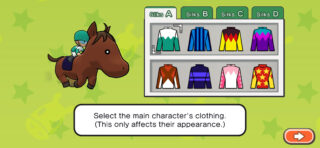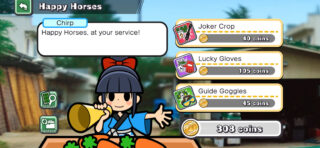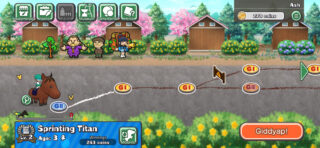Review: Pocket Card Jockey: Ride On ensures Game Freak’s cult favourite won’t go to pasture
The 3DS hidden gem lives on in this Apple Arcade rendition
- Director
- Masao Taya
- Key Credits
- Tetsuya Watanabe (Producer), Satoshi Tajiri (Executive producer)

The original Pocket Card Jockey is one of those hidden gems that not a lot of people have played, but those who have are in love with it.
In just a couple of months the 3DS eShop exclusive, like every other game on the handheld’s digital store, will no longer be available to purchase. It’s a good job, then, that Pocket Card Jockey: Ride On has arrived on Apple Arcade.
Ride On is less a sequel and more an enhanced re-release of Pocket Card Jockey – one that looks notably better than its 3DS predecessor, but doesn’t add anything so revolutionary that it completely changes the way the previous game was played.
For those unfamiliar with the series, the concept sounds bizarre on paper – it’s an unexpected mash-up of horse racing and solitaire – but the execution is handled so well that it feels like a natural combination in practice.
The idea is that each race is split into a series of sections, and during each section the player has to play a game of Solitaire, specifically the Golf variation (otherwise known to some as Tri-Peaks).
This is a simpler version of Solitaire in which you’re presented with a grid of cards all lying face-up and you have to clear them by removing cards in a numerical sequence – for example, you could remove a 3, then a 4, then 5, 6, 7, 6, 5, 6, 7, 8, 9, 8, as long as each of those cards is available to you.
If your sequence ends, you pull another card from your stack, which marks the start of a new sequence. Once you either clear the grid or run out of cards, the round is over.
Your performance in these card-based rounds has a direct impact on your horse’s mood, stamina and enthusiasm, which in turn has an effect on its positioning in the race.
“Your performance in these card-based rounds has a direct impact on your horse’s mood, stamina and enthusiasm, which in turn has an effect on its positioning in the race.”
Clear all the card stages and your horse will be only too happy to go all-out in the final straight, giving you a better chance of winning. Do badly in the card stages, however, and frequently leave spare cards behind, and you’ll be left with a dejected, tired horse who’ll struggle to get over the finish line in a reasonable position.
That’s the basics, but there’s more to it than that. For example, where you manually place your horse on the track affects how difficult each card round is – naturally, the harder a round is the bigger the rewards are if you clear it, but the greater potential there is for a massive disaster if it goes badly.
Other elements also have an impact on your horse’s performance, but the game does its best to sum all these up over the course of three tutorial races. These tutorials can be a little overwhelming, and it’s likely that you’ll still not be entirely sure how everything works when you’re starting your career proper, but the opening career races are easy enough that you can get a grasp of things and the tutorials can always be revisited to help it sink in a little better.
One thing players do need to know going into Ride On is that they will lose. A lot. This is all part of the game’s design, however. As in real horseracing, it’s practically impossible to get a horse that will win every single race it takes part in, especially with the horse you’re initially given in the game.
You start off with a relatively young horse which gets older and gains experience as you take it through a series of races, with your performance in each determining how quickly it levels up. Even if you romp all the early races, however, your first horse is still likely to struggle in many of the main G1 races, in which it’s often taking part against horses that are much stronger and, frankly, have better genetics than yours. Again, that’s just horse racing.
This is also where the game’s longer term mechanics come into play. Once your horse reaches a certain age its performance starts to wane a little, and once it loses a few races in a row the game decides to put it out to pasture. This isn’t Game Over, however, it’s just part of the gameplay loop.
“One thing players do need to know going into Ride On is that they will lose. A lot. This is all part of the game’s design, however.”
You then get to choose a new young horse and go through the entire process again, hoping that its stats, attributes and special abilities lead to a better career than your previous horse had. Once you have a couple of horses out to pasture, this is where things get interesting.
You can breed retired horses to create offspring that inherit some of their parents’ attributes. This means that, over time and over the course of multiple generations, you can potentially breed an all-time champ that builds on its ancestors’ past achievements.
It’s a good way to encourage repeat playthroughs, as is the game’s museum where you can try to tick off all the different cups and collect all the horse breeds across your multiple playthroughs.
This is all supported by brilliantly offbeat dialogue between each race, where you encounter other jockeys, rich businessmen and the like, providing some levity between races.

If there’s one criticism that can be levelled at the game, it’s that – and forgive us for the awful pun – it’s a bit of a one-trick pony.
You complete a 20-race career with one horse, retire it, then choose or breed another horse and continue the process, continually aiming for that one dream horse who can do no wrong. You’ll find yourself becoming oddly emotionally attached to some of these steeds and will grow to resent others, but ultimately hour 100 will feel a lot like hour three.
This is fine if you find yourself hooked on the gameplay loop – like we were on the 3DS and are once again here – but if after a short while you find yourself struggling to get into it, and the fact that not every race will be a win frustrates you, be aware that this is the game, and it doesn’t change much.
This aside, Ride On is a great way for fans of the 3DS version to upgrade to a more modern revamp, and for those who missed out to try out a brilliantly unique concept for the first time. Even better, with the original set to be pulled permanently from sale in March, it ensures that Pocket Card Jockey will continue to be around to race its way into unsuspecting players’ hearts for some time to come.
Like its 3DS predecessor, Pocket Card Jockey takes a delightfully silly premise and uses it to create an oddly engaging and highly engrossing puzzle game. Its repetitive nature makes it a one-trick pony, but if it's a trick you click with it's difficult to put down.
- Its bonkers concept is so compelling
- The move from the 3DS version's pixel art to polygons is a triumph
- Cutscenes are charmingly funny
- Breeding and ancestry system gives the game long legs
- It's repetitive – if you don't 'get' it you likely never will















